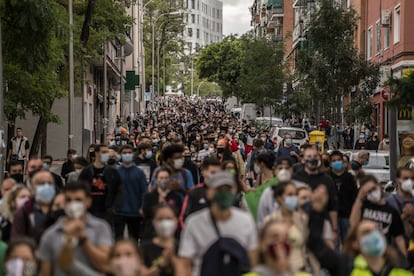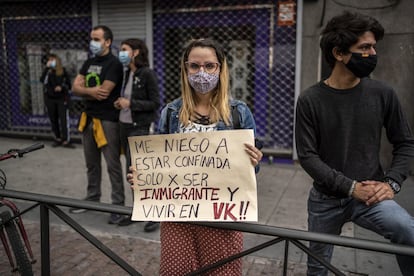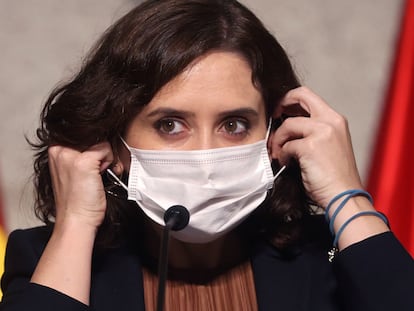Protestors take to the streets to oppose new selective lockdowns in areas of Madrid, calling for regional premier to quit
Thousands of demonstrators assembled outside the parliament building on Sunday, to denounce measures that they claimed are “inefficient and discriminatory”
Several demonstrations took place over the weekend in Madrid in protest at the regional government’s plans to impose selective coronavirus confinements due to the rising numbers of Covid-19 cases and deaths that are being registered in the area.
After a protest on Friday evening in the capital’s central Puerta de Sol square, Sunday saw thousands of people take to the streets in a wave of demonstrations in many of the 37 areas of the city of Madrid and the surrounding region where, from Monday onward, there will be restrictions on mobility.
Called to protest by organizations from a number of neighborhoods, with instructions to wear masks and to respect social distancing, the demonstrators denounced the regional government’s plans as “ineffective and discriminatory,” claiming that they were focused on southern satellite cities such as Fuenlabrada and humble, working-class neighborhoods. They also called for greater investment and resources for local healthcare centers and for public transportation.

One of the biggest crowds formed outside the Madrid regional parliament, where there were moments of tension when the protestors tried to approach the building and the police sought to stop them. “More healthcare and fewer police,” they chanted.
Before midday, dozens of people began to gather outside the parliament, as they shouted a series of slogans in support of the national healthcare system and calling for the resignation of the regional premier, Isabel Díaz Ayuso of the conservative Popular Party (PP). “Long live the fight of the working class,” and “Vallecas defends itself” were among the chants heard, the latter a reference to a working-class neighborhood in the south of the city that is being particularly hard hit by the second wave of the coronavirus. While safe distancing was respected at the start of the protest, the demonstrators ended up closer together as more and more people arrived.
What good the measures do if we are going to have to travel halfway across Madrid to go to and from work?Dolores Solascasas, a teacher in Madrid’s central Tirso de Molina neighborhood
One attendee explained that she had come to complain about the stigma that the measures were creating. “The primary healthcare system is completely overwhelmed and public transportation is packed in the neighborhoods where people who can’t work from home live,” she complained. Her partner works and she is a student, she explained. “With the little money that we earn, it turns out that now we can’t even go out for a wander.”
The administration of Ayuso – which is made up of a coalition of the PP and center-right Ciudadanos (Citizens), and propped up by far-right Vox – has come in for harsh criticism from the opposition and citizens alike, for what has been perceived as inaction ahead of the reopening of schools and the restarting of activity in the region after summer vacations. Last week there was a chaotic series of announcements and denials, after the deputy health chief announced selective lockdowns only for Ayuso’s team to backtrack, saying that nothing had yet been decided.

Among the measures Ayuso finally announced late on Friday, after a series of delays, is the closure of all establishments from 10pm in the 37 affected areas. What is allowed are journeys within the area, but anyone who leaves the perimeter will have to justify their trip for work reasons, for example. Among the other reasons permitted under the new rules are visits to healthcare or educational centers, to banks and to the courts or a notary, as well as the renewal of official documents, exams, the return to your usual place of residence, the care of seniors or dependents or reasons of force majeure. The police will be able to demand that citizens present documentation that attests to the reasons for their movement.
Ricardo Martínez, an office clerk in a healthcare center in Vallecas, complained at the protests on Sunday that the administrations “have done nothing in six months to strengthen [healthcare] services,” and that now it is residents who are suffering as a result. He claimed that the primary healthcare system is on the brink of becoming completely overwhelmed and that the new lockdowns were simply an excuse to cover up bad management.
Dolores Solascasas, a teacher in Madrid’s central Tirso de Molina neighborhood, asked “what good the measures do if tomorrow we are going to have to travel halfway across Madrid to go to and from work?” She showed a photo on her cellphone of a Metro station that was packed with people. “I took this the other day when I was returning to work, when it was already late,” she explained. “So now we’re not going to be able to have a beer in the neighborhood but we can travel to another one to serve them?” she asked, in reference to the closure of hostelry establishments at 10pm in the affected areas under the new measures.
Álvaro Jarabo, also from Vallecas, criticized the motives for the restrictions. “How can you explain that Vallecas is being locked down but other areas with high infection rates such as Lavapiés are not subject to any measures?” The latter neighborhood, located in central Madrid just south of the Puerta del Sol, is currently registering more than a thousand positive cases for every 100,000 inhabitants, which exceeds the 37 areas affected by Ayuso’s new measures. But for now, no restrictions are being implemented there.

According to a statement released by the Federation of Neighborhood Associations in Madrid (FRAVM), the protest was organized via social media in support of the “dignity of the south,” and reflects “not just the deep uneasiness caused by the regional government’s management of the pandemic, but also decades of institutional neglect.”
The primary healthcare system is completely overwhelmed and public transportation is packed in the neighborhoods where people who can’t work from home liveRicardo Martínez, an office clerk in a healthcare center in Vallecas
As well as the protest outside parliament, there were other demonstrations in the districts of Villaverde Bajo, Villaverde Alto, Puente de Vallecas, Villa de Vallecas, Carabanchel Alto, Carabanchel Bajo, Arganzuela and Ciudad Lineal-San Blas, as well as the municipalities of Getafe, Parla, Fuenlabrada, Alcobendas and San Sebastián de los Reyes. At around 1.30pm, when the protest in central Madrid began to move along Martínez de la Riva street, the demonstrators received waves of applause from the windows of nearby apartments.
One of the protestors, Nicolás Lázaro, 55, lives in the Francia area, which will be confined from Monday despite having a cumulative incidence of the coronavirus of 661, much lower than in other areas that have not seen new restrictions. “We don’t understand anything and they are not explaining what it is due to,” he complained.
Lázaro works in maintenance at Madrid’s Complutense University, and he is not afraid of losing his job. But his wife, Trinidad Gil, 52, cleans buildings in the center of Madrid and doesn’t know whether she can continue doing so. “I’ll find out tomorrow,” she said, adding that she felt fortunate because she has a contract. She questioned what will happen to the people who are working off the books, with no official papers. “They won’t be able to claim that they’re employed, it’s all a disaster,” she lamented.
English version by Simon Hunter.
Tu suscripción se está usando en otro dispositivo
¿Quieres añadir otro usuario a tu suscripción?
Si continúas leyendo en este dispositivo, no se podrá leer en el otro.
FlechaTu suscripción se está usando en otro dispositivo y solo puedes acceder a EL PAÍS desde un dispositivo a la vez.
Si quieres compartir tu cuenta, cambia tu suscripción a la modalidad Premium, así podrás añadir otro usuario. Cada uno accederá con su propia cuenta de email, lo que os permitirá personalizar vuestra experiencia en EL PAÍS.
¿Tienes una suscripción de empresa? Accede aquí para contratar más cuentas.
En el caso de no saber quién está usando tu cuenta, te recomendamos cambiar tu contraseña aquí.
Si decides continuar compartiendo tu cuenta, este mensaje se mostrará en tu dispositivo y en el de la otra persona que está usando tu cuenta de forma indefinida, afectando a tu experiencia de lectura. Puedes consultar aquí los términos y condiciones de la suscripción digital.
More information
Últimas noticias
Most viewed
- Sinaloa Cartel war is taking its toll on Los Chapitos
- Oona Chaplin: ‘I told James Cameron that I was living in a treehouse and starting a permaculture project with a friend’
- Reinhard Genzel, Nobel laureate in physics: ‘One-minute videos will never give you the truth’
- Why the price of coffee has skyrocketed: from Brazilian plantations to specialty coffee houses
- Silver prices are going crazy: This is what’s fueling the rally











































